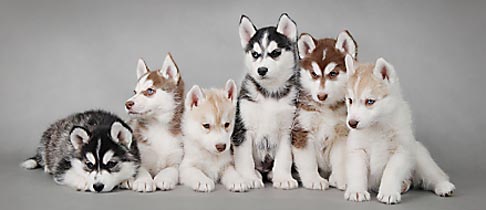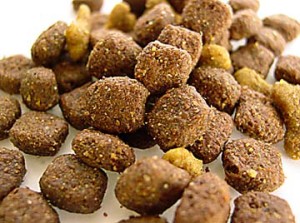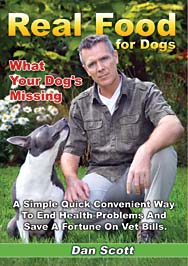 Raw feeding dogs has come a long way these last few years as people are really starting to understand the huge health benefits of this natural dog food diet. Much of the change is due to the sheer lack of understanding by the veterinary profession which rather than try to recognize and accept raw feeding for dogs are doing their best to block progress.
Raw feeding dogs has come a long way these last few years as people are really starting to understand the huge health benefits of this natural dog food diet. Much of the change is due to the sheer lack of understanding by the veterinary profession which rather than try to recognize and accept raw feeding for dogs are doing their best to block progress.
Why?
Because the AMVA (American Medical Veterinary Association) see a threat to their shoulder to shoulder monopoly with the corporate dog food giants and the extortionate profits made from cheap food waste passed off as premium dog food in cans and packets.
What’s so Bad About The Contents of Dog Food?
When was the last time you checked out the label on your dogs can or packet of dinner?
Did you even understand what it all meant?
To say the ingredients list is confusing is an understatement… why is that and why can’t it be simple to understand for regular people concerned that what their pets are getting to eat is healthy?
Well let’s dig into this subject a little and discover a few home truths.
There are NO laws to keep pet food quality enforced; only the AAFCO (Association of American Feed Control  Officials) guidelines which mean the corporate food giants are free to “self police”. This also means they can produce artificial dog food to their own standard based on maximizing profits. And their get out of jail card is the classic line you read on most every dog food “formulated to meet the nutritional levels established by the Association of American Feed Control Officials (AAFCO) Dog Food Nutrient Profile for All life stages”…. Yes and pigs fly south for the winter.
Officials) guidelines which mean the corporate food giants are free to “self police”. This also means they can produce artificial dog food to their own standard based on maximizing profits. And their get out of jail card is the classic line you read on most every dog food “formulated to meet the nutritional levels established by the Association of American Feed Control Officials (AAFCO) Dog Food Nutrient Profile for All life stages”…. Yes and pigs fly south for the winter.
In contrast, human food is strictly controlled by law so high standards are maintained, because let’s face it, what they can get away with for shareholder profits, they will and it’s only a “guideline” after all – too easy!
Think about it, if you were a hard pressed pet food plant manager seeking lower costs to maximize profits and the “crude protein” ingredients you buy in are $200 a ton for beef protein and $40 a ton for protein made from “chicken feather extraction” (a major protein producing industry) which one would you opt for? (Keeping in mind there’s no law to stop you).
Imagine you’re making a home cooked meal version of your pet food as a special treat for your canine family member. You have decided to buy all the ingredients listed on the pet food label. You want to make it tasty and enjoyable for them to eat, so you thought you’d try out the recipe for yourself.
Pet Food Giant ‘X’ Special Pet Food Surprise: Ingredients
Propylene glycol:
Similar to antifreeze for your car and found in semi-moist foods to maintain moisture content and texture. As  studied, this ingredient can be addictive to cats and can destroy red blood cells.
studied, this ingredient can be addictive to cats and can destroy red blood cells.
Propyl Gallate (E310):
Antioxidant used to stop fats and oils from going rancid. This is used in chewing gum and meat products. This one’s banned in children’s foods in the US as a possible cause of blood disorders like methemoglobinemia.
Ethyoxiquin:
A common preservative used in animal food, however it’s also thought most likely to cause serious damage to animals. Ethyoxiquin was created to stabilize rubber and is listed as a pesticide in the US. This one is linked to cancer of the kidneys.
Butylated hydroxytoluene (BHT):
This common preservative is used to stop fats from going rancid. Implicated in bladder and thyroid cancer plus damage to the liver.
Butylated hydroxyanisole (BHA):
Another preservative to stop fats going rancid. Linked to stomach cancer, learning difficulties in children and hyperactivity.
Artificial colors:
 Pet food contains many artificial colors like Red No.2 and Violet No.1 which are linked to cancer, birth defects and skin lesions. Similar dyes have been banned from human food production for the same reasons.
Pet food contains many artificial colors like Red No.2 and Violet No.1 which are linked to cancer, birth defects and skin lesions. Similar dyes have been banned from human food production for the same reasons.
At the Asthma and Allergy Research Centre in the UK, they studied the effects of artificial colorings in foods. The studies concluded that the effects on children’s behavior were significant from E102, E110, E122, E124 and E211. Once removed from the children’s diet, the symptoms disappeared in as little as two weeks. Notice the brightly colored pieces in your dogs kibble or canned food?
Cereals:
Look at your dog’s pet food label EU, UK AUS, does it state “cereals” anywhere in the list? They don’t tell you the cereals used because they can change with the seasons and what’s available for the right prices at any given time. You simply have no way of knowing what’s in the product. In the US the cereals are stated such as:
- Ground rice
- Brown rice
- Whole grain corn
- Corn gluten meal
- Brewers rice
- Barley
- Whole grain wheat
- Oatmeal
- Rye flour
- Ground millet
- Ground whole grain sorghum
- Ground whole grain barley
Dogs have no dietary requirement or need for carbohydrates. Their liver derives energy directly from the protein in their biologically appropriate diet of raw meat and bones. Carbohydrates are included in the ingredients of processed pet food because they are a less expensive source of energy than fat or protein
 These carbohydrate ingredients are from a range of canned and dry dog food products on the market. It’s important for a dog not to eat carbohydrates in any quantity as they quickly turn to sugars which create imbalance in your dogs digestive system that can feed bad bacteria and kill off beneficial bacteria. The sludge from packet food forms hard mucus like rubbery film that smothers the lining of your dog’s digestive tract. This creates multiple problems:
These carbohydrate ingredients are from a range of canned and dry dog food products on the market. It’s important for a dog not to eat carbohydrates in any quantity as they quickly turn to sugars which create imbalance in your dogs digestive system that can feed bad bacteria and kill off beneficial bacteria. The sludge from packet food forms hard mucus like rubbery film that smothers the lining of your dog’s digestive tract. This creates multiple problems:
- Limits nutrient absorption into the body so the system extracts far less of what it needs from the food.
- Creates an unbalanced micro flora environment in the gut which causes upset, swelling, diarrhea, gas and chronic disease like bowel and colon cancer plus repeated bacterial ear infection from gunky-yeasty buildup (mites are then attracted to this unbalanced environment).
If you take a look at the label on your dog’s can or packet food you will see the ingredients above. None of the above ingredients provide optimal or balanced nutrition for your dog regardless of the AFFCO free pass.
Meat content:
Any label that says “meat”, “animal”, “by-product meal” or “derivative” is hiding the true identity of that ingredient. That’s because it includes feathers, beaks, hair, feet, heads, faeces, grit, sand, sawdust, hooves, horns and fluffy – see video below!
How much meat is in your dog’s dinner?
For example:
- If the label states ‘Beef’ then 70-100% must be beef.
- If the label states ‘Beef Dinner’ then 10-70% must be beef.
- If the label states ‘Beef Flavor’ then 0-4% must be beef.
- If the label starts ‘with Beef or contains Beef’ then it must contain at least 4% beef.
- If two or more main ingredients are stated e.g. ‘Beef and Rice’ then they must be 10-70% of the food (and each one must be greater than 3%)
(Burger and Thompson, 1994)
Unfortunately, the sample ingredients above are just part of a list of 29 synthetic chemical additives dog food manufacturers have to choose from to add to the food to preserve, color, enhance flavor and so on. The combination of cheap industrial food waste and chemical additives adds up to cheaply sourced ingredients that’s low cost to produce.
Pet food at maximum profit and no laws – too easy when all they have to say is “formulated to meet the nutritional levels established by the Association of American Feed Control Officials (AAFCO)
Watch this short video clip and understand the farce that is AFFCO nutritional guidelines!
Now imagine you cooked up that special doggy meal using the above ingredients, would you still prepare it?
And perhaps more importantly, would you still buy the commercial equivalent knowing what’s really in it and the possible health consequences of doing so?
Because the giant food corporations run the food industry, they use all their power to control the target demographic; you and your dog. They do this with convincing advertising, sponsorship of veterinary universities and close links to the veterinary medical board and the drug industry, what’s known as a “closed shop”. The constant media clamor for your attention is hard to ignore, but when you pull back the curtain to see the truth, it’s not hard to realize that we are being played as fools as out dogs suffer shortened ailment filled life spans because of corporate greed.
Who’s in Your Corner?
This may be hard for you to accept as your vet certainly won’t agree for obvious reasons; he sells the commercial stuff from his practice! The pet manufacturers TV ads won’t agree, AAFCO won’t agree as they look the other way. Your friends down at the dog park may not agree either after a lifetime of persuasive dog food commercials, high minded vets who think they know best on canine nutrition but in reality are not animal nutritionists. YOU are basically on your own if you want to break the mould, think outside the box and help your dog to a healthy longer lived life.
Dan Scott: “I Will Always be There for You and Your Dog”
 A lifetime of great health feeding raw food to dogs that’s actually pretty easy once you get going is now the way to go. And the difference between the outcome from commercial dog food and feeding dogs raw is like night and day…. Don’t get left in the dark!
A lifetime of great health feeding raw food to dogs that’s actually pretty easy once you get going is now the way to go. And the difference between the outcome from commercial dog food and feeding dogs raw is like night and day…. Don’t get left in the dark!
If this article has helped in any way please share with friends, family and work colleagues.
Please share your thoughts below and you can contact me anytime should you need my help.




when you say raw food, what type of raw food do you mean?
Hi Joni, pretty much any raw (meat-on-the-bone) food we eat but left in it’s raw state for best nutritional value to our dogs.
Dan How do I buy your book?
Does it give you a step by step for preparing and storing large batches {freezing }etc. recipes?
I have 3 dogs . Please advise. Loren
Hi Loren, sorry about the book not being up. I took down the page to prepare for the new 2014 edition and then hit delays, so really sorry.
The good news is it’s out next week 18/10/13. So check back then.
I do go into storage for several months batches and step by step, yes.
After speaking to Dan before getting my last dog we have been feeding her a combination of raw lamb ribs (frozen) and Naturediet. People comment how young she looks (she’s now 7 but has the stamina of a two or 3 year old) and she is slim and gorgeous!
Hi Lynne, glad to hear from you and so happy your dog doing great on the diet.
This sort of monopoly sounds similar to doctors and pharmaceutical sales reps and manufacturers. I liken this to how doctors tend to push prescription drugs on their patients because it means more revenue for both parties. So they bill the HMO or the patient’s insurance and the cash flow continues. But it could be the patient that ends up suffering in the long run, addicted to prescription drugs instead of using a more natural alternative form of medicine..
Hey Ron, so true, there are so many parallels between dogs and humans when it comes to food and drugs. Thanks for your insights, much appreciated.
If you read the headline and a few keywords, you’d think this is some radical conspiracy theory. But when you read the article in its entirety, you notice certain facts that make sense and a few things that you can’t deny. I noticed that every dog owner I’ve known, who has an old dog, has had problems with arthritis. To dismiss this or accept it as a natural effect of old age is like assuming that all humans will develop severe arthritis in their old age.
Hi Matthew, the proof is in the eating, fresh raw fed dogs rarely get arthritis – that’s natural.
I was an over the road truck driver for awhile and I would go to feed lots and things to pick up loads of meat to go to businesses and I know what they were putting into the waste piles to go to the dog food factory so that is why I have not been feeding my dog the prepackaged stuff. You have done a great post here keep up the good work.
It would make sense that if what we eat as humans determines how we feel and how active we are that the food we are feeding our dogs would be the same way. I am going to look into that “Blue dog food I have seen because they say it is natural and raw. Thank you for this post my dogs are very important to us.
No problem John, glad I could help.
Hi Laura, thanks. Not surprised you don’t feed commercial processed dog food after what you’ve seen!